McLaren’s 12C Spider and Ferrari’s 458 Spider share remarkable similarities: both are powered by mid-mounted V8s, both are paddleshift-only and rear-wheel drive, both use folding hard-tops, and both cost around £200,000. But the way these dream machines drive couldn’t be more different. Read on for Ben Pulman’s complete feature…
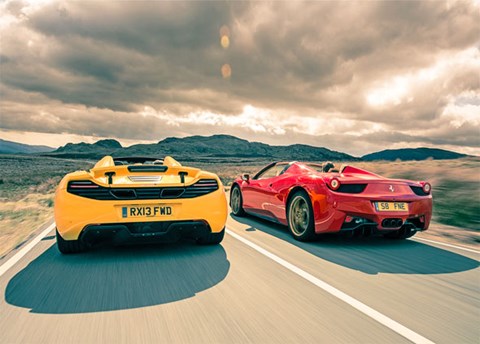
In a summer so wet Noah should be rushing to B&Q for a saw and all the timber he can lay his hands on, a peculiar golden orb has appeared over north Wales and granted us brief sanctuary from the rain. It’s doubtful the noisy arrival of a shrieking red Ferrari and shouting yellow McLaren has scared away the inclement weather to quite the extent that chops-to-be have bounded for the woolly safety of their mothers, but regardless, the roads that ribbon across Snowdonia are dry and ready for Spiders 458 and 12C. Trick roofs fold away, embarrassing bobble hats are donned, then two evocative shapes resume their duel across this beautiful and ancient landscape.
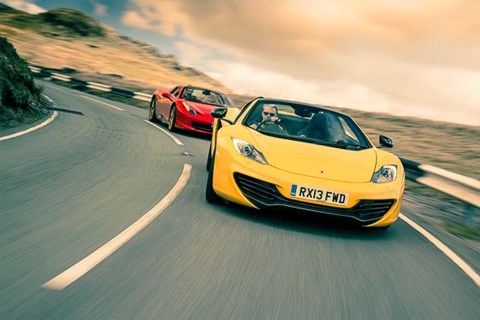
Thanks to their makers’ obsessive rivalry, the 458 and 12C are inseparable. They’re different yet similar, and fight for the same space, like Dr Who and Star Wars fans brawling at the fourth annual Norwich Sci-Fi Convention. The history is simple: when the 458 Italia was unleashed McLaren stopped benchmarking against anyone but Ferrari, and the two traded public blows over the respective merits of carbonfibre and aluminium construction, of turbocharged versus naturally aspirated engines, of F1-inspired Brake Steer against active differentials. By the time 12C faced off against 458 it felt like nothing else mattered.
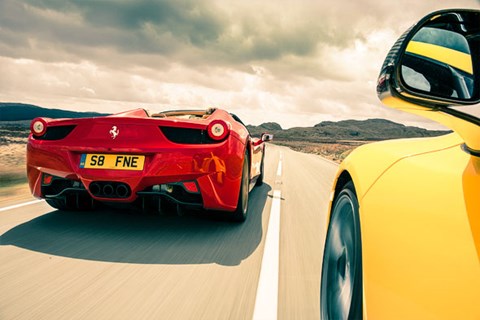
Yet despite the rich race heritage, the technical promise, the hype, even a dose of patriotism, the 12C lost, all of the CAR team preferring the intensity of the Ferrari to the slightly anodyne McLaren. The blame seemed to lie with how the Macca was conceived: from the moment it was unveiled we were teased with technical details and told its superiority over the 458 could be statistically proven. There was even an algorithm – McLaren’s Vehicle Performance Index – that plotted Woking’s wunderkind against rivals across key criteria and expressed its capabilities mathematically. But you can’t distil the essence of a supercar – that most emotive of automobiles – into a number. Especially the number 12.

Two years on though, and a different figure might be about to transform the 12C: 40. It’s the number of kilos gained in the transformation from hard-top to new drop-top Spider, and with the two-piece composite roof folded beneath the rear tonneau, the increased exposure to the elements and that stonking twin-turbo V8 should crank up the excitement. There are further changes too, with all 12Cs from 2013-onwards getting an extra 24bhp, quicker gearshifts, an improved throttle response, and more intake noise from the switchable Intake Sound Generator.
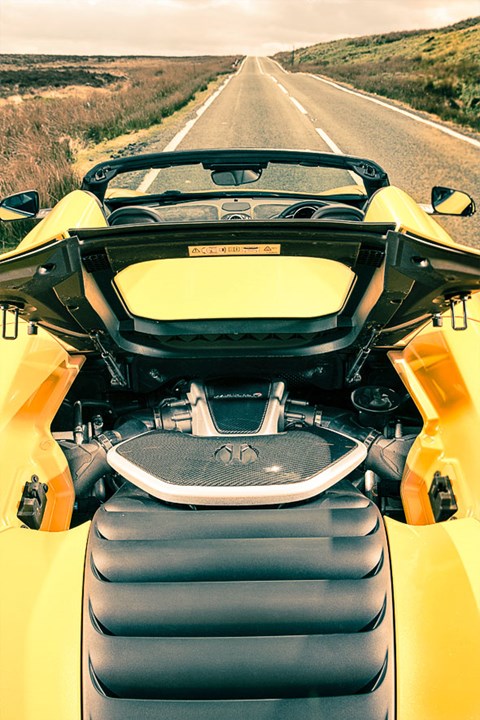
With 80% of the 1400 12Cs built each year predicted to be the Spider, this is the McLaren that matters. This is the rematch then, Kasparov against Deep Blue, only with more fuel burnt and sheep scared than when a Russian chess grand master sat opposite an IBM computer in the ‘90s.
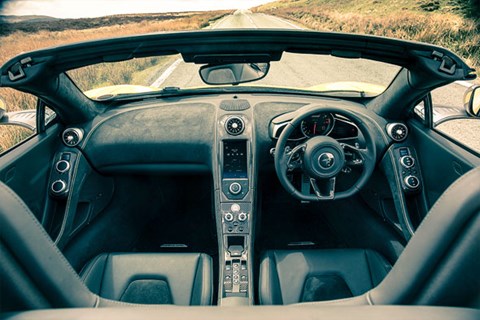
Despite the snorting red Ferrari waiting to fight, you immerse yourself in the McLaren in a deliberate manner. You smile as the drama-laden dihedral door swings upwards – taking a chunk of sill with it to aid your entry into the minimalist cabin – to reveal a beautiful carbonfibre wheelarch. You twiddle with the same air vents that cool Whitmarsh and co on the pitwall, and play with McLaren’s own touchscreen multimedia system (turned 90 degrees to the horizontal norm, so you get to see more of your onward journey on the screen). And aside from the 3.8-litre twin-turbo engine barking surprisingly loudly into life and rumbling unevenly like a carburettor-fed V8, you’d never know of the potency.
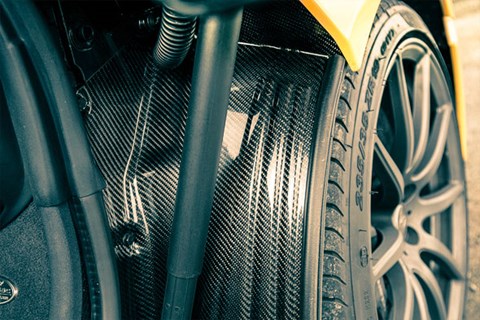
It’s the ride you notice next: it’s Rolls-Royce comfortable, maybe better. ProActive Chassis Control means the 12C has double wishbones and coil springs at each corner, but no anti-roll bars. Instead the dampers are hydraulically interconnected, so each wheel effectively operates independently of the others. You can dial roll stiffness into the system when needed, but around town, on the motorway, everywhere, the 12C rides with a level of compliance to shame a Phantom. With the gearbox seamlessly shifting through the gears, and both pedals moving with Porsche-like levels of mechanical quality, this is a supercar that’s superb at moving slowly.

And outstanding at going fast. Even with the seven-speed ’box left in Drive and the suspension in its most compliant setting the 12C is quicker than almost everything else, so serene is the ride and so strong its 616bhp. But through the Active Dynamics Panel in the centre console you can dial the Powertrain and Handling settings up from Normal to Sport and onto Track. Fiddle with the former and there’s a more aggressive throttle, faster shift times and a louder engine; adjust the latter and rather than just firmer dampers you can feel the lateral stiffness of the whole car increasing.
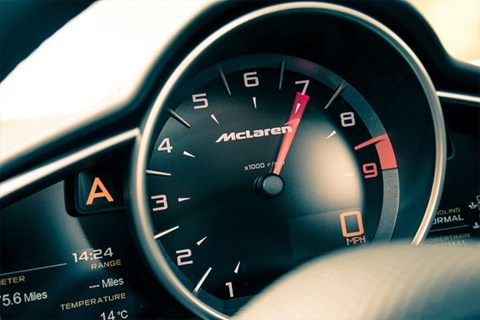
The 3.8-litre V8 is astonishingly strong too, smacking like Rupert Murdoch’s third wife. It’s got the torque of a turbo engine, yet revs like it’s naturally aspirated: 443lb ft is yours from 3000rpm to 7000rpm (by which point most turbo motors are hitting their limits) but the redline is 8500rpm. Only 911 GT3s and Ferraris go higher, and that peerless breadth – from low-rev oomph to high-rev hysterics – means the 12C makes huge lunges in every gear. And with the roof down there’s a Veyron-esque cacophony of hisses and whistles and rumbles from the wastegates, blowers
and exhausts.
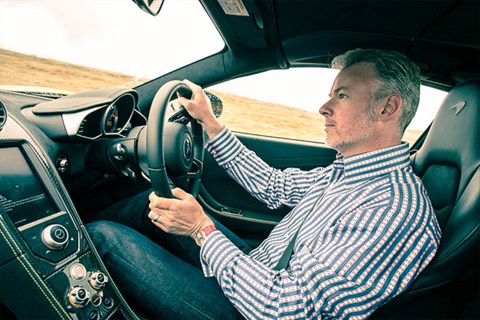
Reverse the process and the ceramic brakes (monstrous, but a monstrous £10,200 option that irks more when you realise they’re standard on the Ferrari) haul you up relentlessly, and when the Airbrake pops up to assist, you feel the rear end of the 12C squash down into the road. Through hairpins and tight bends you occasionally sense the Brake Steer system gently massaging the inside rear wheel, mimicking the action of a locking differential, and the 12C deploys its monumental power with seeming ease.
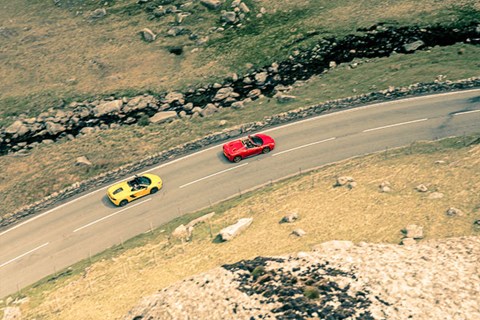
There’s nothing to distract you from the task of going fast either: the wheel is free from buttons and switches, forward visibility is superb, and there’s not a shimmy or a shake from the chassis, the carbonfibre monocoque meaning the Spider doesn’t require any additional strengthening. The clever hydraulic suspension means the 12C corners flat and hard too, but all remains serene and calm inside the cabin, even in Track mode. Bumps you see – and your mind prepares for – never reach your bottom, so you concentrate, never feel intimidated, and let the McLaren translate its potential performance to the road more efficiently and effectively than any other car. It’s serene, sometimes alarmingly so, because often you don’t realise quite how quickly you’re going.
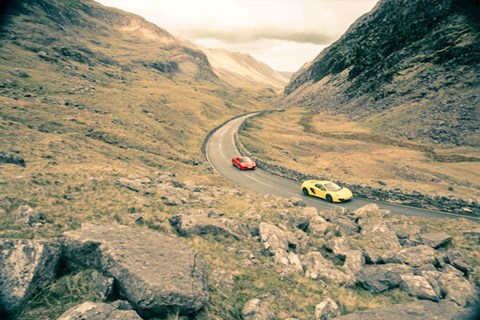
It’s an utterly different sensation in the 458. You prod that cherry starter button, crank the manettino dial round to at least Race, and then incessantly chase the moment when all five red LEDs are illuminated in the carbonfibre steering wheel, when the white needle in the big yellow rev counter is pointing at 9000rpm, and the noise from the triple exhausts is washing into the cabin in waves and entirely enveloping your world. The 563bhp V8 shrieks and screams and barks, and the pitch and tone changes with every twitch of your toes on the pin-sharp throttle. You play with the slender carbonfibre paddles, lost in the romance of driving a Ferrari, in awe of the noises that never leave you. It always feels fast.
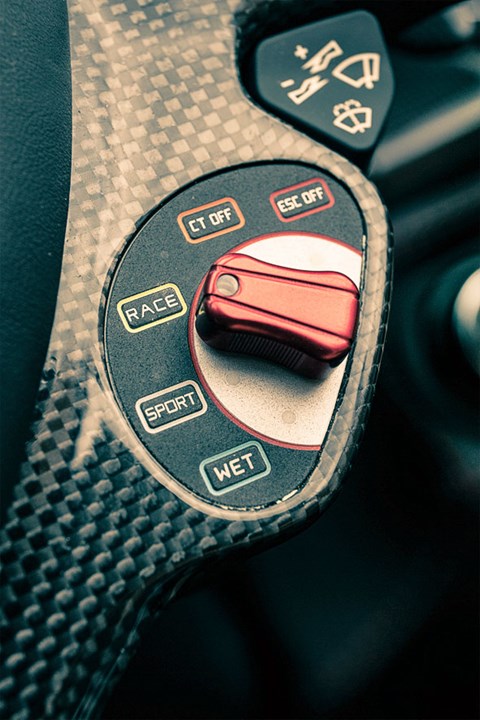
The 458’s extra weight and torque deficit means it doesn’t have the same almighty punch as the twin-turbo 12C, but you’ll never care. The gearshifts are sharper and faster, the steering much quicker, and the brakes are firmer and bite harder. You can select a ‘bumpy road’ setting for the dampers too, and although it’s not McLaren smooth, it’s not at all bad. Not that you’ll really notice, as there are few more intoxicating and all-encompassing experiences than driving a 458 Spider at full chat. It feels so alive, so life affirming.
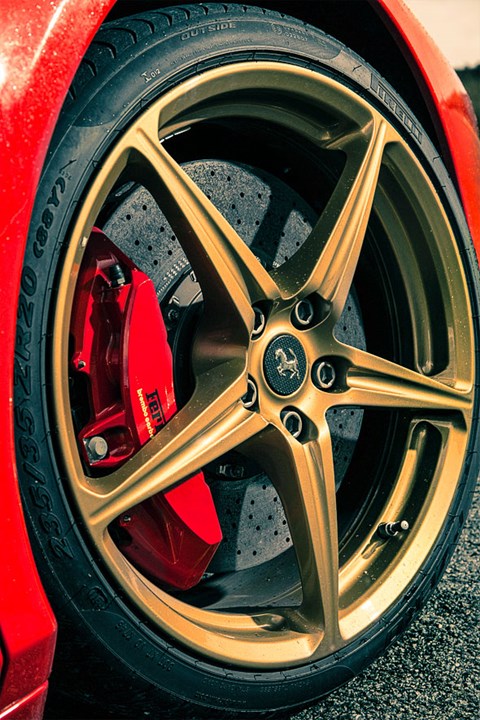
Dial it back though, and you notice where the Ferrari falters. It’s hardly a Fiat Panda through the corners, but back-to-back with the 12C’s trick suspension there’s some front-end roll, exaggerated by the 458’s super-fast steering. And with the roof folded away the aluminium structure is noticeably not as stiff as the carbon McLaren 12C’s, the Ferrari’s steering column trembling when you hit catseyes and cattle grids.
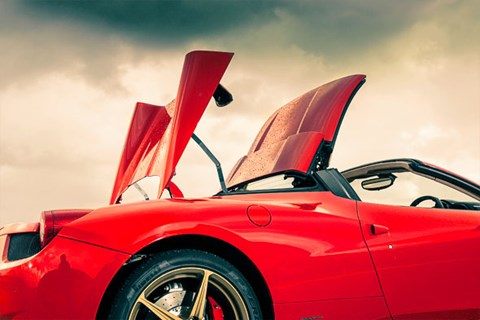
You’ll tremble too, when you see the bronzed interior, the colour reminding me a little too much of BNP-candidate-for-South-Shields Lady Dorothy MacBeth Brooke. That, and the £507 fire extinguisher seems an extravagance when the 458’s rear wheelarches no longer spontaneously ignite. Those might be faults particular to this car, but what isn’t unique are the muddle of buttons and screens; I’ve been lucky enough to drive 458s on three occasions now, and I still find the infotainment system as confusing as the Melvyn Bragg radio show I accidently stumble upon.
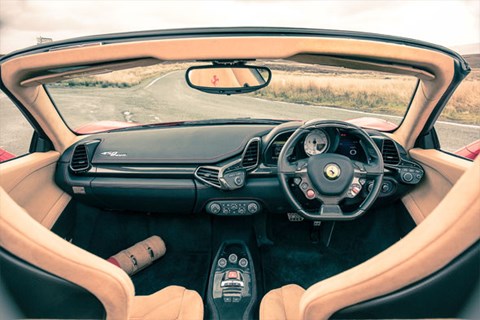
However, the 458 also excels where the 12C should be supreme. The wraparound windscreen and smaller rear buttresses mean better forward and over-the-shoulder visibility than in the McLaren, but there’s less buffeting with the roof down too. And although that epic 4.5-litre V8 barks into life like the KFC colonel realising his secret recipe has been stolen, it idles surprisingly quietly. By contrast the 12C is deafeningly noisy, and no matter how you configure the Intake Sound Generator, at tickover it’s louder even than that voice we all use when speaking English to foreigners.
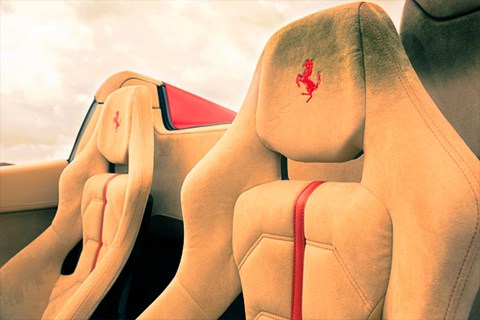
The more we switch between the cars, the more minor differences are magnified. After the Ferrari you notice the McLaren’s turbo lag, that you’re taking multiple bites at a corner as you re-adjust to life after the Italian’s hyper-quick rack, and (childish, this one) you can’t select neutral by pulling both paddles when there’s a minibus full of kids wanting you to blip the throttle. And above 60mph with the roof down, the roar of the 12C’s engine is lost in the roar of the wind; it’s akin to driving in silence, and like copulation without the squeals of ecstasy, where’s the fun in that? Then when you’re in the 458 with Pac-Man in your mirrors you can become frustrated with the on/off throttle, the lack of ultimate steering feedback, the average cabin quality, and as glorious as that engine sounds, once in a while you actually just want it to shut up.
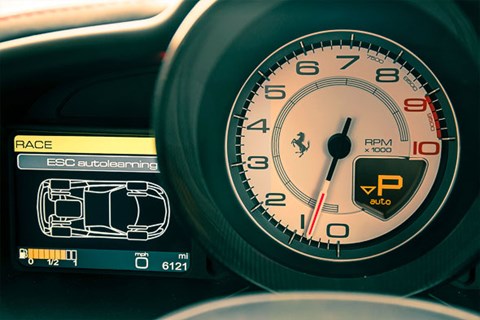
I don’t make a decision that day in Wales, and even now I’m not entirely sure of the result. The McLaren 12C Spider is stunningly impressive, nearly perfect, more interactive and involving than the Coupe we first drove on these same roads two years ago, and almost certainly technically superior to the Ferrari 458. All that’s missing (and I’m sure this will make me sound simplistic) is a soundtrack as intoxicating as the Ferrari’s.
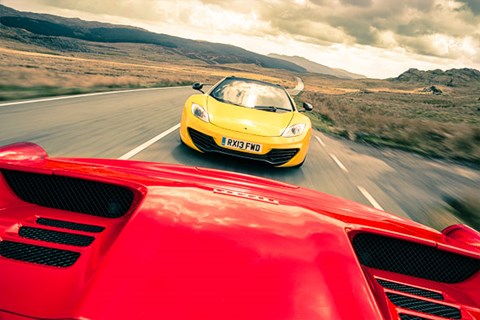
I want to pick the 12C. In isolation it’s incredible, and I want to vindicate McLaren’s decision to build such a staggeringly capable and complete game-changing supercar. If you want to use a supercar as a daily drive, this is your car. But the driving experience just isn’t as immersive, as searingly memorable, as a flat-out drive in the Ferrari. The Italian supercar has that extra tenth, its amazing highs are fractionally more intoxicating. If I was in the market for a plaything to blow my mind and scramble my emotions every now and then, I’d blow £200k on the Ferrari 458.
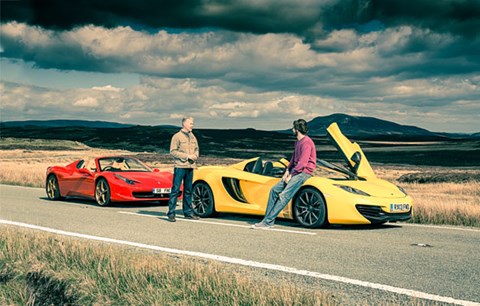
Words: Ben Pulman Photography: Mark Fagelson